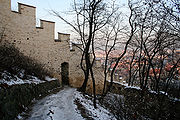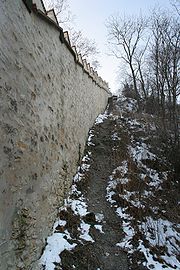
Hladová zed
Encyclopedia


Prague
Prague is the capital and largest city of the Czech Republic. Situated in the north-west of the country on the Vltava river, the city is home to about 1.3 million people, while its metropolitan area is estimated to have a population of over 2.3 million...
, today's Czech Republic
Czech Republic
The Czech Republic is a landlocked country in Central Europe. The country is bordered by Poland to the northeast, Slovakia to the east, Austria to the south, and Germany to the west and northwest....
. It was built on Petřín Hill during 1360 - 1362 by order of Charles IV
Charles IV, Holy Roman Emperor
Charles IV , born Wenceslaus , was the second king of Bohemia from the House of Luxembourg, and the first king of Bohemia to also become Holy Roman Emperor....
.
Marl
Marl
Marl or marlstone is a calcium carbonate or lime-rich mud or mudstone which contains variable amounts of clays and aragonite. Marl was originally an old term loosely applied to a variety of materials, most of which occur as loose, earthy deposits consisting chiefly of an intimate mixture of clay...
from quarries on Petřín Hill was used as construction material. The purpose of the construction was to strengthen the fortifications of Prague Castle
Prague Castle
Prague Castle is a castle in Prague where the Kings of Bohemia, Holy Roman Emperors and presidents of Czechoslovakia and the Czech Republic have had their offices. The Czech Crown Jewels are kept here...
and Malá Strana
Malá Strana
Malá Strana is a district of the city of Prague, Czech Republic, and one of its most historic regions.The name translated into English literally means "Little Side", though it is frequently referred to as "Lesser Town", "Lesser Quarter", or "Lesser Side"...
against any attack from the west or south. Originally the wall was 4-4.5 meters high and 1.8 meter wide and was equipped with battlement
Battlement
A battlement in defensive architecture, such as that of city walls or castles, comprises a parapet , in which portions have been cut out at intervals to allow the discharge of arrows or other missiles. These cut-out portions form crenels...
s and (probably) eight bastion
Bastion
A bastion, or a bulwark, is a structure projecting outward from the main enclosure of a fortification, situated in both corners of a straight wall , facilitating active defence against assaulting troops...
s.
The wall was repaired in 1624, further strengthened in the middle of 18th century and repaired or modified several times later (in modern era in 1923-25 and 1975). One of preserved bastions serves as a base for the dome of Štefánik Observatory.
The name and associated myths
The wall was originally called Zubatá (with teeth) or Chlebová (bread like). The adjective Hladová (hunger) appeared after a 1361 famineFamines in Czech lands
This article discusses historical famines that have occurred in the area of today's Czech Republic. Various known famines occurred throughout Czech lands between 1272 and 1847...
, when the construction of the wall provided livelihood for the city's poor. According to myth, the purpose of the wall was not strategic but to employ and thus feed the poor. Another myth, recorded in writings of Václav Hájek z Libočan or Bohuslav Balbín
Bohuslav Balbín
Bohuslav Balbín was a Czech writer and Jesuit, the "Bohemian Pliny," whose Vita beatae Joannis Nepomuceni martyris was published in Prague, 1670,...
, is that the Emperor Charles IV
Charles IV, Holy Roman Emperor
Charles IV , born Wenceslaus , was the second king of Bohemia from the House of Luxembourg, and the first king of Bohemia to also become Holy Roman Emperor....
himself worked on the wall several hours every day "to help his beloved people".
The term hladová zeď has become a Czech
Czech language
Czech is a West Slavic language with about 12 million native speakers; it is the majority language in the Czech Republic and spoken by Czechs worldwide. The language was known as Bohemian in English until the late 19th century...
euphemism for useless public works
Public works
Public works are a broad category of projects, financed and constructed by the government, for recreational, employment, and health and safety uses in the greater community...
.

